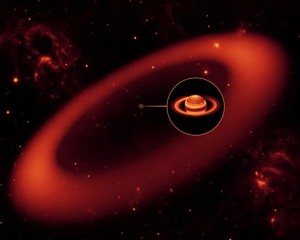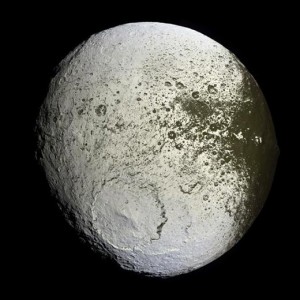Saturn’s Massive Newfound Ring
/https://tf-cmsv2-smithsonianmag-media.s3.amazonaws.com/filer/20110520102257Saturns-ring-520-300x240.jpg)
NASA's Spitzer Space Telescope has discovered a new ring around Saturn. This ring is very different from those previously known. In some ways, this ring resembles the "accretionary disk" found around some stars more than it resembles the thin, orderly rings that Saturn is famous for.
The new ring is much larger than any of the planet’s other rings and is tilted about 27 degrees off the main plane of rings. It starts about six million kilometers out from the planet, and is about 12 million kilometers wide. The moon Phoebe orbits just within this ring and is tentatively thought to be responsible for the ring's existence. It would appear that as Phoebe circles around Saturn, it occasionally collides with comets, which are obliterated, with the debris from the collision contributing to the ring.
This ring is different from the other rings not only in its angle, but also in its thickness. The better known Saturnian rings are very thin (about 10 meters thick), but this mega-ring measures about 2.5 million kilometers thick. That is roughly 20 times the diameter of Saturn. As Anne Verbiscer, one of the authors of the study reporting this feature, puts it, "This is one supersized ring. If you could see the ring , it would span the width of two full moons' worth of sky, one on either side of Saturn."

The ring appears to be made out of very dispersed particles of ice and dust, which were visible to the Spitzer telescope using its infrared detectors. The particles are spread out so thinly that if you were in the thickest part in a spacecraft, you would not easily detect the ring's existence. The Spitzer instruments were able to "see" the ring only because they were very sensitive to even tiny amounts of infrared radiation emanating from the particles making up the ring.
The discovery helps solve a mystery regarding the Saturnian moon Iapetus. Iapetus has an odd appearance whereby one side is bright and the other is really dark, in a pattern resembling a yin-yang symbol. The dark area is called the Cassini Regio, after Giovanni Cassini who discovered Iapetus in 1671 and later described its dark side.

Iapetus, the previously known rings of Saturn and most of Saturn's moons circle in one direction, while the newly discovered mega ring circles the other way. It appears that the material from this ring splatters Iapetus—think of bugs hitting a windshield—as the moon and the ring move in opposite directions.
For more information, see NASA's Spitzer Space Telescope web site.
/https://tf-cmsv2-smithsonianmag-media.s3.amazonaws.com/accounts/headshot/greg-laden-240.jpg)
/https://tf-cmsv2-smithsonianmag-media.s3.amazonaws.com/accounts/headshot/greg-laden-240.jpg)